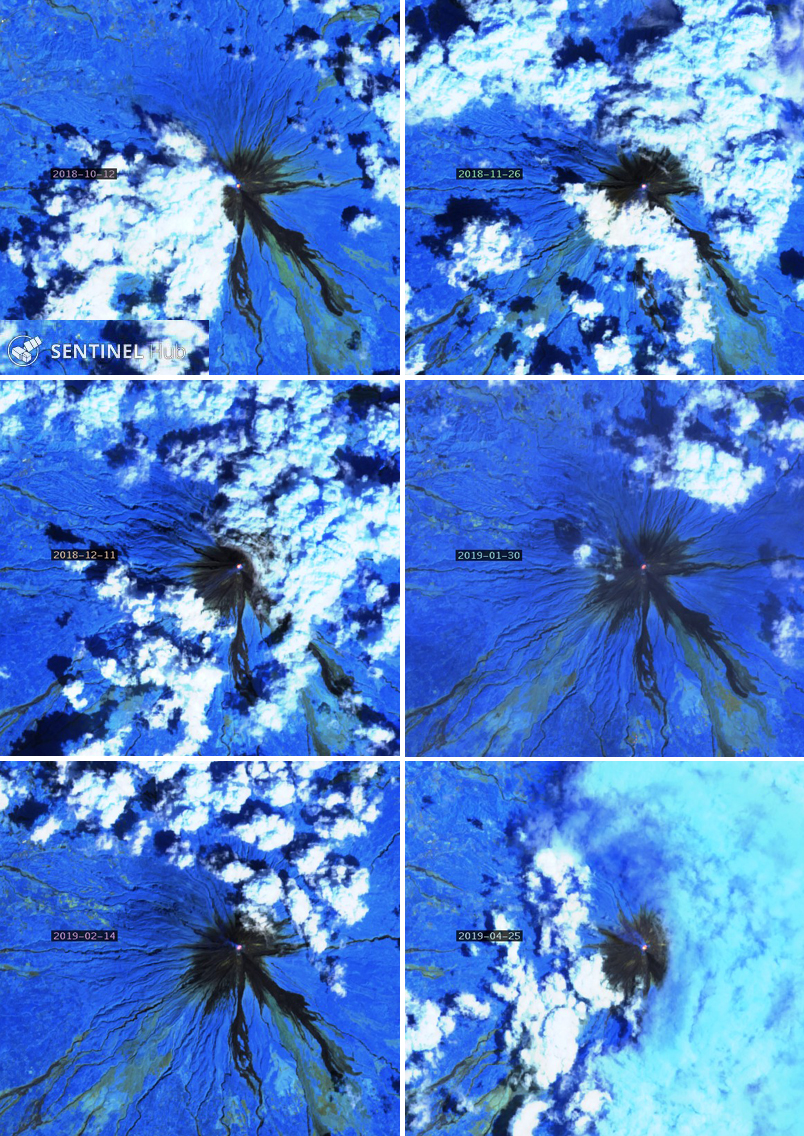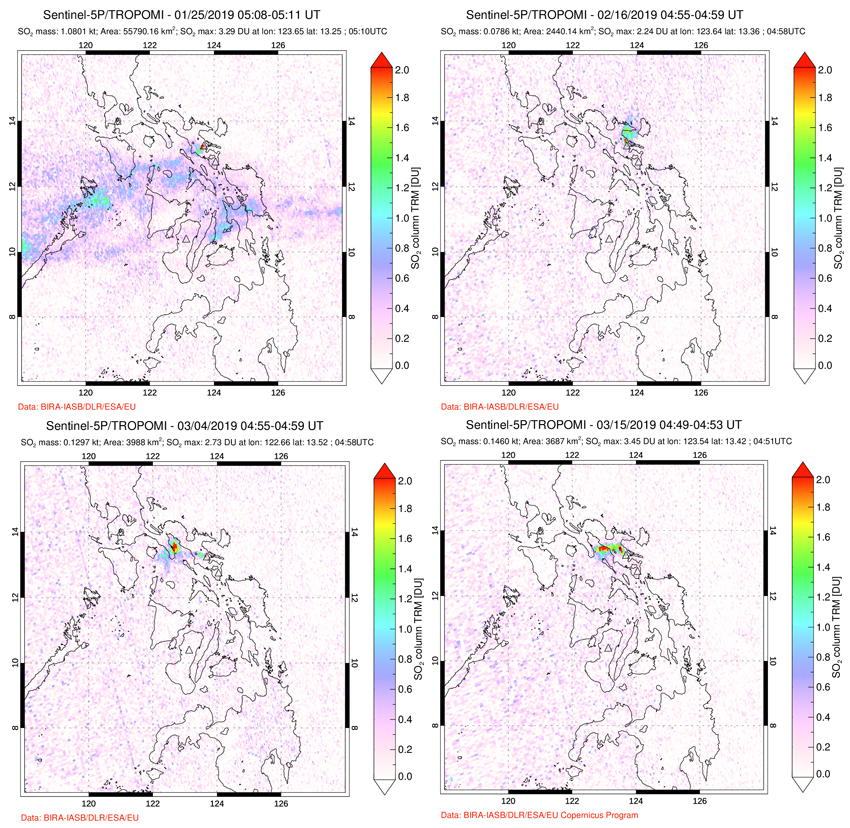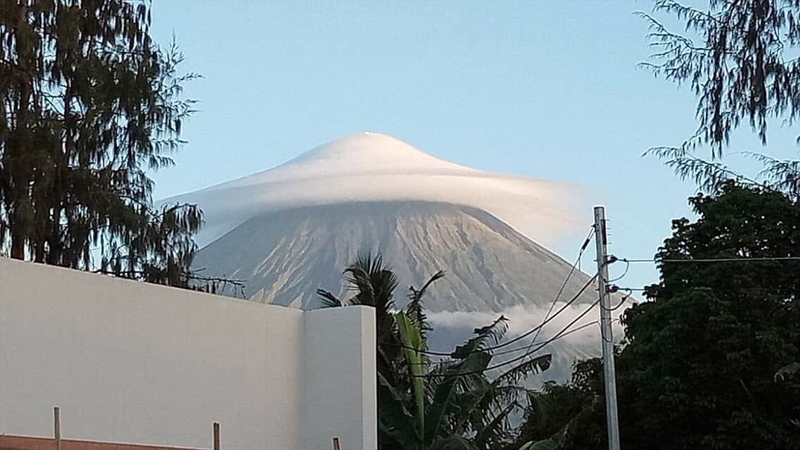Report on Mayon (Philippines) — May 2019
Bulletin of the Global Volcanism Network, vol. 44, no. 5 (May 2019)
Managing Editor: Edward Venzke.
Edited by A. Elizabeth Crafford.
Mayon (Philippines) Intermittent ash emissions; persistent summit incandescence, October 2018-April 2019
Please cite this report as:
Global Volcanism Program, 2019. Report on Mayon (Philippines) (Crafford, A.E., and Venzke, E., eds.). Bulletin of the Global Volcanism Network, 44:5. Smithsonian Institution. https://doi.org/10.5479/si.GVP.BGVN201905-273030
Mayon
Philippines
13.257°N, 123.685°E; summit elev. 2462 m
All times are local (unless otherwise noted)
Steep-sloped and symmetrical Mayon has recorded historical eruptions back to 1616 that range from Strombolian fountaining to basaltic and andesitic flows, as well as large ash plumes, and devastating pyroclastic flows and lahars. A phreatic explosion with an ash plume in mid-January 2018 began the latest eruptive episode which included the growth of a lava dome with pyroclastic flows down the flanks and lava fountaining (BGVN 43:04). Activity tapered off during March; occasional ash emissions continued through August 2018. Minor ash emissions and summit incandescence were intermittent from October 2018-April 2019, the period covered in this report. Information is provided primarily by the Philippine Institute of Volcanology and Seismology (PHIVOLCS).
Pyroclastic density currents were reported in early November 2018; ash plumes were produced from phreatic events a few times during both November and December 2018. Emissions produced SO2 anomalies during January-March 2019; a series of events in early March generated several small ash plumes. Satellite images showing a thermal anomaly at the summit were recorded multiple times each month from October 2018-April 2019 (figure 44).
Very little activity was reported at Mayon during October 2018. Steam plumes rose daily from 250-750 m above the summit before drifting with the prevailing winds and dissipating. Incandescence was observed at the summit most nights during the month, and seismicity remained low with only a few earthquakes reported. Leveling data obtained during 30 August-3 September indicated significant short-term deflation of the volcano relative to 17-24 July 2018. New leveling data obtained on 22-31 October indicated inflation of the SE quadrant and short-term deflation on the N flank relative to the 30 August-3 September data. The volcano remained inflated compared with 2010 baseline data. Electronic tilt data showed pronounced inflation of the mid-slopes beginning 25 June 2018.
Activity increased during November 2018. In addition to steam plumes rising to 750 m and an incandescent glow at the summit most nights, pyroclastic density currents and ash plumes were reported. The seismic monitoring network recorded pyroclastic density currents on 5 and 6 November. On 8 November around noontime, a small, short-lived brownish ash plume, associated with degassing, drifted WSW from the summit. A seismic event on the morning of 11 November was associated with a short-lived fountaining event that produced a brownish-gray ash plume that drifted SW. Another similar plume was reported on the morning of 12 November, also drifting SW before dissipating. Two phreatic events were observed on the morning of 26 November. They produced grayish to grayish-white ash plumes that rose 300-500 m above the summit before drifting SW. The following morning, another event produced a grayish ash plume 500 m above the summit that drifted SW. On 30 November a 1-minute-long ash emission event produced a grayish white plume that also drifted SW.
Steam plume emissions and incandescence at night continued at Mayon during December 2018. The seismic network recorded a four-minute-long event shortly after noon on 9 December that produced a grayish-brown ash plume which drifted W. Precise leveling data obtained on 8-13 December 2018 indicated a slight inflation of the volcano relative to 22-31 October 2018. A 30-second-long ash emission event in the afternoon on 18 December produced a brownish ash plume. Two phreatic events were observed on the morning of 27 December. They produced grayish to grayish-white ash plumes that rose 600 and 200 m above the summit, before drifting SW (figure 45).
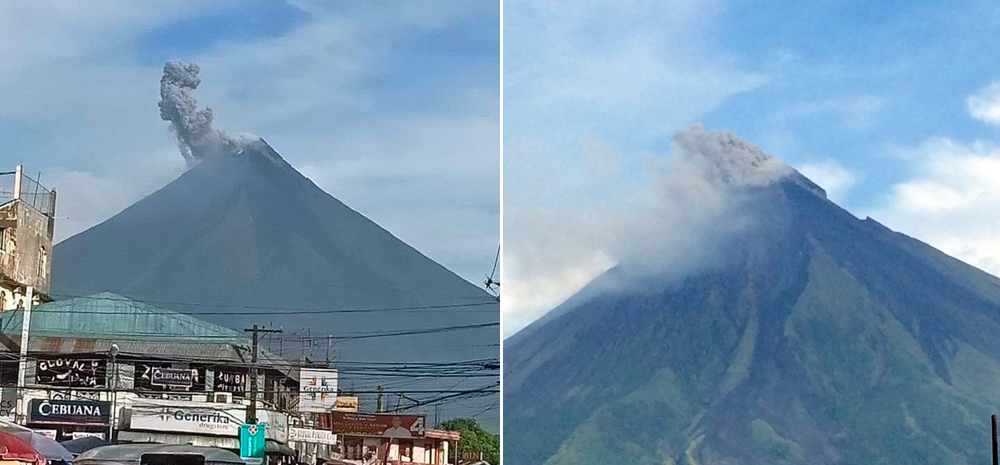 |
Figure 45. Ash plumes rose a few hundred m from the summit of Mayon on 27 December 2018. Courtesy of Twitter users "k i t" (left) and "georgianne" (right). |
Very little surface activity except for white steam-laden plumes that crept downslope and drifted NW or SW was noted during January 2019. Incandescence at the summit, visible with the naked eye, became more frequent during February 2019, along with continued steam plumes. Precise leveling data obtained on 25 January-3 February 2019 indicated a slight deflation relative to 8-13 December 2018. However, continuous GPS and electronic tilt data showed inflation of the mid-slopes since June 2018. Small SO2 plumes were detected by the TROPOMI satellite instrument a few times during January-March 2019 (figure 46).
Steam plumes rose 250-500 m above the summit and drifted generally W in early March 2019; incandescence continued daily at the summit. Phreatic events occurred on 7 and 8 March, producing ash plumes that rose 500 and 300 m from the summit before drifting SW (figure 47). Three more phreatic events occurred on the afternoon of 12 March; they produced light brown to grayish ash plumes that rose 500, 1,000, and 500 m, respectively, and drifted SW. Six phreatic events occurred throughout the day on 13 March, producing ash plumes that rose 200-700 m above the summit and drifted W. A single explosion the next day produced a 500-m-tall ash plume. The Tokyo VAAC reported an ash plume visible for several hours in satellite imagery drifting W at 3.7 km altitude on 13 March (UTC). An increase in the daily number of rockfall events from 1-2 per day to 5-10 per day was noted during the second half of March. Precise leveling data obtained on 20-26 March 2019 indicated a slight inflation relative to 25 January-3 February 2019.
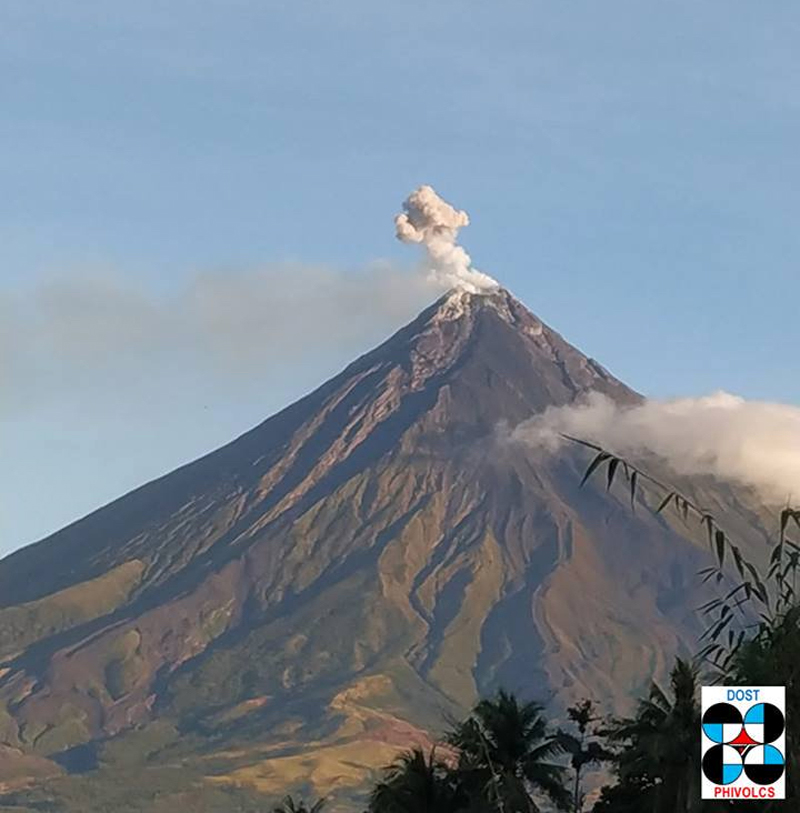 |
Figure 47. A small ash emission at Mayon was reported by PHIVOLCS on 8 March 2019; the plume rose 300 m from the summit and drifted SW. Courtesy of PHIVOLCS. |
Steam plumes drifted SW or NW throughout April, rising 200-400 m from the summit. Incandescence could be observed at night for the first half of the month. Leveling data obtained during 9-17 April 2019 indicated a slight inflation relative to 20-26 March 2019. Seismicity remained low during the month with only occasional volcanic earthquakes and rockfall events. Lenticular clouds around the summit were observed (figure 48), but these are an unusual meteorological occurrence caused by weather conditions not related to volcanic activity.
Geological Summary. Symmetrical Mayon, which rises above the Albay Gulf NW of Legazpi City, is the most active volcano of the Philippines. The steep upper slopes are capped by a small summit crater. Recorded eruptions since 1616 CE range from Strombolian to basaltic Plinian, with cyclical activity beginning with basaltic eruptions, followed by longer term andesitic lava flows. Eruptions occur predominately from the central conduit and have also produced lava flows that travel far down the flanks. Pyroclastic flows and mudflows have commonly swept down many of the approximately 40 ravines that radiate from the summit and have often damaged populated lowland areas. A violent eruption in 1814 killed more than 1,200 people and devastated several towns.
Information Contacts: Philippine Institute of Volcanology and Seismology (PHIVOLCS), Department of Science and Technology, University of the Philippines Campus, Diliman, Quezon City, Philippines (URL: http://www.phivolcs.dost.gov.ph/); Global Sulfur Dioxide Monitoring Page, Atmospheric Chemistry and Dynamics Laboratory, NASA Goddard Space Flight Center (NASA/GSFC), 8800 Greenbelt Road, Goddard, Maryland, USA (URL: https://so2.gsfc.nasa.gov/); Tokyo Volcanic Ash Advisory Center (VAAC), 1-3-4 Otemachi, Chiyoda-ku, Tokyo, Japan (URL: http://ds.data.jma.go.jp/svd/vaac/data/); Sentinel Hub Playground (URL: https://www.sentinel-hub.com/explore/sentinel-playground); Twitter user "Ivan", Naga City, Philippines (URL: https://twitter.com/ivanxlcsn); Twitter user "k i t", Legazpi City, Philippines (URL: https://twitter.com/jddmgc); Twitter user "georgianne", Costa Leona, Philippines (URL: https://twitter.com/xolovesgia_).


